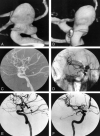Endovascular treatment of intracranial wide-necked aneurysms using three-dimensional coils: predictors of immediate anatomic and clinical results
- PMID: 14970036
- PMCID: PMC7974599
Endovascular treatment of intracranial wide-necked aneurysms using three-dimensional coils: predictors of immediate anatomic and clinical results
Abstract
Background and purpose: Aneurysms with a wide neck constitute a persistent challenge for endovascular therapy with coils. Our purpose was to evaluate the immediate anatomic and clinical results of treating intracranial wide-necked aneurysms by using three-dimensional (3D) coils.
Methods: During a 2-year period, 160 aneurysms (116 with a neck < or = 4 mm, group A; 44 with a neck > 4 mm, group B) in 157 patients in eight participating centers were consecutively treated. The procedure consisted first of framing the aneurysm with one or more 3D spherical coils and then filling it with helical coils. Results were evaluated with univariate analysis. Multivariate analysis was used to identify independent predictors of these results.
Results: Angiographic occlusion was complete in 84 (72%) and 30 (68%) aneurysms in groups A and B, respectively. Mean percentage of volumic occlusion in these groups was 30.9% and 29.2%, respectively. Perioperative morbidity and mortality rates were 4%, respectively, in group A and 2%, respectively, in group B. No significant difference between the two groups was observed. However, percentage of volumic occlusion correlated with sac-to-neck ratio less than 1.5 (P =.061) and with sac size (P =.002) except when three or more 3D coils per aneurysm were used (P =.222). The better the percentage of volumic occlusion, the better the degree of angiographic occlusion (P =.004). Percentage of volumic occlusion was an independent predictor of angiographic complete occlusion (P =.001). World Federation of Neurological Surgeons subarachnoid hemorrhage scale grade 5 was an independent predictor of perioperative mortality (P =.043).
Conclusion: Three-dimensional coils proved to be useful for improving coil packing and angiographic and volumic occlusion of aneurysms with a neck greater than 4 mm, at the time of treatment, provided the sac-to-neck ratio was 1.5 or greater, and the largest number of 3D coils were first positioned.
Figures







Similar articles
-
Unruptured intracranial aneurysms treated by three-dimensional coil embolization: evaluation of the postoperative aneurysm occlusion volume.Neuroradiology. 2005 Jun;47(6):438-45. doi: 10.1007/s00234-004-1320-1. Epub 2005 May 20. Neuroradiology. 2005. PMID: 15906022
-
Selective occlusion of basilar artery aneurysms using controlled detachable coils: report of 35 cases.Neurosurgery. 1996 May;38(5):948-53; discussion 953-4. doi: 10.1097/00006123-199605000-00019. Neurosurgery. 1996. PMID: 8727820
-
Endovascular treatment of intracranial aneurysms with matrix detachable coils: immediate posttreatment results from a prospective multicenter registry.AJNR Am J Neuroradiol. 2006 Sep;27(8):1693-9. AJNR Am J Neuroradiol. 2006. PMID: 16971616 Free PMC article. Clinical Trial.
-
Selection of cerebral aneurysms for treatment using Guglielmi detachable coils: the preliminary University of Illinois at Chicago experience.Neurosurgery. 1998 Dec;43(6):1281-95; discussion 1296-7. doi: 10.1097/00006123-199812000-00011. Neurosurgery. 1998. PMID: 9848841 Review.
-
Safety, immediate and mid-term results of the newer generation of hydrogel coils in the treatment of ruptured aneurysms: a multicenter study.J Neurointerv Surg. 2017 Apr;9(4):419-424. doi: 10.1136/neurintsurg-2016-012780. Epub 2016 Oct 18. J Neurointerv Surg. 2017. PMID: 27798856 Review.
Cited by
-
Y-stenting endovascular treatment for ruptured intracranial aneurysms : a single-institution experience in Korea.J Korean Neurosurg Soc. 2012 Sep;52(3):187-92. doi: 10.3340/jkns.2012.52.3.187. Epub 2012 Sep 30. J Korean Neurosurg Soc. 2012. PMID: 23115659 Free PMC article.
-
Experiences of neuroform stent applications for ruptured anterior communicating artery aneurysms with small parent vessel.J Korean Neurosurg Soc. 2010 Jul;48(1):53-8. doi: 10.3340/jkns.2010.48.1.53. Epub 2010 Jul 31. J Korean Neurosurg Soc. 2010. PMID: 20717512 Free PMC article.
-
Focal increased cortical density in immediate postembolization CT scans of patients with intracranial aneurysms.AJNR Am J Neuroradiol. 2006 Oct;27(9):1866-75. AJNR Am J Neuroradiol. 2006. PMID: 17032858 Free PMC article.
-
Endovascular treatment of wide-neck, ruptured and unruptured aneurysms without supporting devices. A single center experience.Neuroradiol J. 2013 Feb;26(1):97-105. doi: 10.1177/197140091302600117. Epub 2012 Dec 8. Neuroradiol J. 2013. PMID: 23859176 Free PMC article.
-
Detachable coil for cerebral aneurysms: in vitro evaluation of magnetic field interactions, heating, and artifacts at 3T.AJNR Am J Neuroradiol. 2005 Feb;26(2):363-6. AJNR Am J Neuroradiol. 2005. PMID: 15709137 Free PMC article.
References
-
- Guglielmi G, Viñuela F, Dion J, Duckwiler G. Electrothrombosis of saccular aneurysms via endovascular approach, II: preliminary clinical experience. J Neurosurg 1991;75:8–14 - PubMed
-
- Horowitz MB, Levy E, Kassam A, Purdy PD. Endovascular therapy for intracranial aneurysms: a historical and present status review. Surg Neurol 2002;57:147–158 - PubMed
-
- Viñuela F, Duckwiler G, Mawad M. Guglielmi detachable coil embolization of acute intracranial aneurysm: perioperative anatomical and clinical outcome in 403 patients. J Neurosurg 1997;86:475–482 - PubMed
Publication types
MeSH terms
LinkOut - more resources
Full Text Sources
Other Literature Sources
Medical
